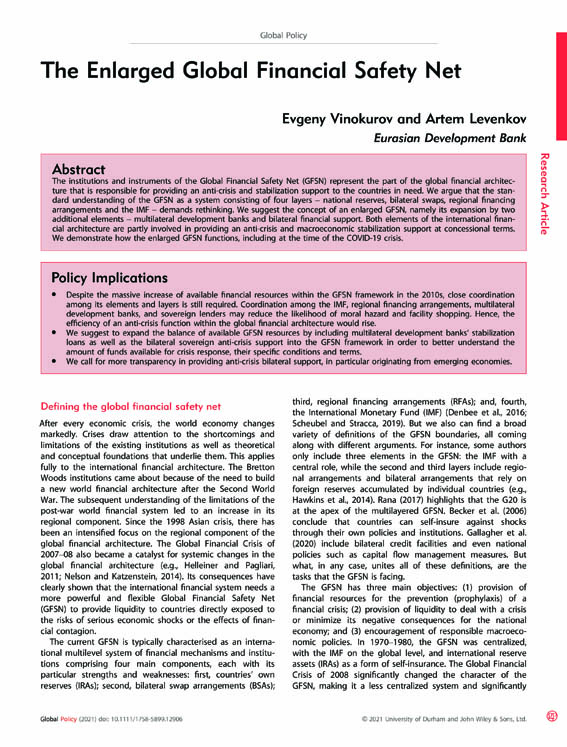
The Enlarged Global Financial Safety Net
Vinokurov E., Levenkov A. (2021) The Enlarged Global Financial Safety Net. Global Policy, January. doi.org/10.1111/1758-5899.12906
The research paper aims to provide analysis of the current state of the Global Financial Safety Net (GFSN) in the global financial architecture. The authors introduce and substantiate the concept of an enlarged Global Financial Safety Net.
The COVID-19 pandemic highlighted the dire demand for better global risk management. The institutions and instruments of the GFSN are responsible for providing anti-crisis and stabilization support to the countries in need. The current representation of the GFSN as a system consisting of national reserves, bilateral swaps, regional financing arrangements, and the IMF does not fully correspond to reality on the ground. Despite the fact that policymakers can access a broad range of institutions to draw on for liquidity support, the distribution and availability of the current GFSN resources are still uneven, with many countries having access only to a relatively small part of the GFSN resources. In addition, the relationships between institutions at different layers require coordination in order to strengthen the complementarity of different GFSN elements.
In order to address these challenges, the authors suggest the concept of an enlarged GFSN expanded by two additional elements – multilateral development banks and bilateral financial support. Both of them may be viewed as systemically important sources of financing within the GFSN. If carefully combined, they ensure an additional benefit of evening out geographical coverage of the regional financing arrangements and bilateral swap arrangements.
Multilateral development banks and bilateral support already play a substantial role in the global financial safety net architecture and its regional components. Both elements of the international financial architecture are partly involved in providing an anti-crisis and macroeconomic stabilization support at concessional terms. The rapid response and considerable size of the financial resources allocated by MDBs in 2020 demonstrate the importance of considering such resources as part of the GFSN.
The paper proves that the phenomenon of an enlarged GFSN is not limited to one region, but has universal significance.
With new advantages, there also come new risks. There is a burning issue of coordination within the GFSN and the risks of moral hazard on the part of borrowers. A higher degree of coordination would also help participating institutions to converge on uniform approaches, prevent unnecessary and counterproductive competition and facility-shopping by recipient countries. This would ensure the greatest effectiveness of crisis support and financing. The authors also stress the importance of promoting more transparency in designing and providing anti-crisis bilateral support, especially for emerging economies. Expanding GFSN is crucial in order to provide additional lending tailored to the recovery phase in 2021–2022. In this relation, the IMF, MDBs and the RFAs could further collaborate on the exit strategy policies in a special working level format.
Policy Implications
- Despite the massive increase of available financial resources within the GFSN framework in the 2010s, close coordination among its elements and layers is still required. Coordination among the IMF, regional financing arrangements, multilateral development banks, and sovereign lenders may reduce the likelihood of moral hazard and facility shopping. Hence, the efficiency of an anti-crisis function within the global financial architecture would rise.
- The authors suggest to expand the balance of available GFSN resources by including multilateral development banks’ stabilization loans as well as the bilateral sovereign anti-crisis support into the GFSN framework in order to better understand the amount of funds available for crisis response, their specific conditions and terms.
- The authors call for more transparency in providing anti-crisis bilateral support, in particular originating from emerging economies.